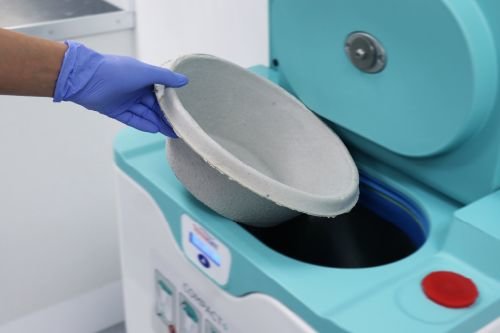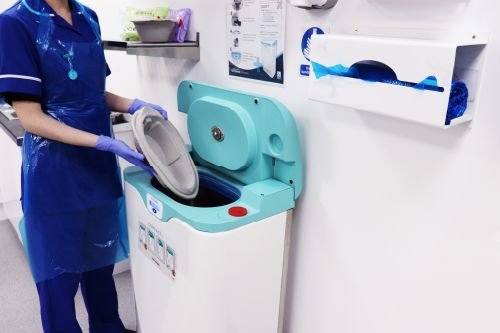
What is a Sluice Room?

What is a Sluice Room?

What is a Sluice Room?
A sluice room (often referred to as a dirty utility room) is a closed room found in healthcare facilities such as hospitals and nursing homes, that is specifically designed for the disposal of human waste products and disinfection of associated items.
Human waste products such as urine, vomit and faecal matter can often be infectious, so it is vital that sluice rooms are planned carefully, to ensure that waste is disposed of safely, reducing the risk of cross infection.
What happens in a sluice room?
When delivering care to patients, many items can become contaminated with bodily fluids; steps are taken in a sluice room to ensure that this waste is properly disposed of, without any risk of cross contamination.
There are several reasons a healthcare professional may need to use a sluice room, these include:
Discarding of disposables such as used bedpans, vomit bowls and wipes
Disinfecting medical equipment and surgical instruments
Storing clean products such as bedpans and wipes for use
When a healthcare professional enters a sluice room carrying an item contaminated with bodily fluids, it is essential that this is disposed of quickly, with minimal human contact. There are several different ways that healthcare facilities dispose of human waste and the receptacles (some more effective than others). The method chosen will depend on whether the item is reusable or disposable.
Reusable Items
Reusable items, such as bedpans, jugs and washbowls need to be thoroughly disinfected before being reused, to ensure the patient is not exposed to any harmful bacteria. There are two options for cleaning reusable items:
Washing the item by hand
Cleaning the item in a thermal disinfection unit
Whilst traditionally all healthcare facilities used reusable items, there is now a large body of evidence to demonstrate that this is now not the most effective method of waste disposal. Primarily this is because reusable items are often not fully decontaminated after being washed, posing a serious infection risk to the next patient who uses them.
Disposable Items
Disposable items, such as medical pulp, are only used once, consequently eliminating the risk of cross contamination. These items can be disposed of in clinical waste bins, however it is recommended that they are disposed of in a hospital macerator. Hospital macerators quickly dispose of medical pulp products and their contents by breaking waste down into a fine slurry before flushing it to drain. This is often regarded as the most hygienic method of waste disposal.
Once the waste and receptacle have been dealt with, healthcare professionals need to ensure that they are not transmitting bacteria. To do this they should first dispose of any personal protective equipment (PPE) such as their gloves and coveralls, they should then thoroughly decontaminate their hands and lower arms, to prevent any onward transfer of harmful organisms.


How to use a sluice room?
A sluice room should be designed with infection prevention in mind, to eliminate the risk of transmitting infection to both healthcare professionals and patients. Usually a sluice room will be divided in to two areas, one for ‘dirty’ activities and one for ‘clean’ activities. New and cleaned products such as bedpans and wipes will be stored in a clean storage area, away from any ‘dirty’ activities, to ensure they do not become contaminated before use.
It is crucial that sluice rooms are used in the way they were designed, to reduce potential cross contamination of dangerous bacteria. This means that ‘dirty’ activities should only take place where they are designated. If, for example, a contaminated item is placed on a surface where it is not intended, the bacteria may begin to spore on that surface, putting others at risk of infection.
Healthcare professionals should therefore carefully follow all guidelines put in place by the healthcare facility. These guidelines might include, procedures for how waste should be disposed of, effective hand washing procedures and guidance on how a sluice room should be cleaned and disinfected.
All these procedures are crucial for ensuring a safe environment that is free from infection.
Vernacare can solve your sluice room needs!
The disposal of human waste is a very important consideration for hospitals, insufficient procedures could lead to wasted nurse time and a heightened risk of infection. In response to inadequate procedures, Vernacare pioneered the full system solution more than 50 years ago.
Hospital macerators are regarded as the safest and most hygienic method of waste disposal. At Vernacare we produce a full range of pulp toileting products that can be disposed of after use in a macerator, ensuring that every patient receives a clean container every time and eliminating the risk of cross infection.
Our hospital macerators are particularly effective thanks to our patented SmartFlow™ Technology. SmartFlow™ works by pumping water into a closed macerator drum to fully saturate the bedpan, breaking it down into a fine consistency, before it is flushed safely to drain.
We also produce a range of maceratable wipes for both patient cleansing and environmental cleaning. These can also be disposed of in a macerator after use to reduce the risk of infection further, whilst also preventing any macerator blockages.